Types of Rock
(1) Welded tuff
- Type:
- Sedimentary rock
- Sampling site:
- Anagetani, Kansaka, Okuhida Hot Spa, Takayama city
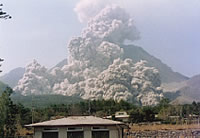
Pyroclastic flow
(1991, Mt. Unzen Fugendake, Nagasaki prefecture)
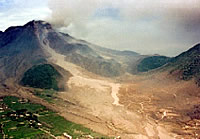
Pyroclastic flow occurred repeatedly and volcanic ash is piled up
(1991, Mt. Unzen Fugendake, Nagasaki prefecture)
Large eruption of a volcano causes a pyroclastic flow. A pyroclastic flow is a phenomenon of a mixture of mainly hot volcanic gas and volcanic ash rapidly gushing out of the crater downward around. In general, it never ends in a single occurrence. It repeatedly occurs a few hundred or thousand times. When a pyroclastic flow stops, a large volcanic gas mingles with the atmospheric air, and volcanic ash alone is deposited. As the constituents of volcanic ash are very close to shards of glass, still highly heated glass shards compress, deform, stretch and adhere to each other as they are piled up. This process is called welding action, and hard rocks formed out of this process are called welded tuff.
Although this term is often understood to mean that "volcanic ash is molten, cooled down and solidified to become rocks", the welded tuff is actually formed in a process of glass shards molten, stretched and mutually bonded.
The welded tuff exhibited here is produced by pyroclastic flows from Mt. Kasagatake that actively repeated eruption from about 65 million to 50 million years ago.
Source: Volcano [11] Welded Tuff, the Geology of Gifu website, with partial modification
(2) Takidani Granodiorite
- Type:
- Plutonic rock (igneous rock)
- Sampling site:
- Konabedani, Kansaka, Okuhida Hot Spa, Takayama city
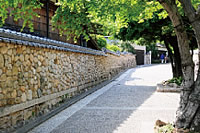
Granite widely used in various ways such as building material for external wall or gravestone
Photo: Jinzu River Sabo Office, Hokuriku Regional Development Bureau, MLIT
Granite, one of the rocks made of magma cooled and solidified in a great depth (plutonic rock), is one of the most popular rocks in Japan, with its distribution covering about 11.6% of the ground surface of Japan. Also called "Mikage-ishi" in Japanese, it is widely used in various ways including external walls of buildings, torii gates, and gravestones.
The sample, Takidani Granodiorite, is the world's newest granite found around the North Japan Alps. You may feel strange when you hear a rock born 1.2 million years ago is the "world's newest". Its newness, however, becomes outstanding when you know the majority of granite seen in Japan were formed about 70 million to 100 million years ago. The area around Mt. Hodaka was characterized by eruptive activities of a large caldera volcano about 2 million years ago. The magma present about a few kilometers down the volcano was hardened over a period of about 800,000 years and mostly solidified about 1.2 million years ago. The resultant rock is Takidani Granodiorite.
In other words, rocks currently exposed in the North Japan Alps were originally magma that existed deep underground and rose up to the ground. Those rocks are new, which means they moved upward very rapidly. Assuming the magma was originally present about 3,000 m underground, the present Takidani Granodiorite is located nearly at an above-sea level of 3,000 m, which means it moved about 6,000 m in 1.2 million years. In a year, the upward movement is about 5 mm. Although the cause of this rapid rise is not clearly known, the buoyancy of magma alone cannot explain it. It is therefore considered that the east-west compressive force by the plate movement is related to this rise.
Source: The World's Newest Granite, Takidani Granodiorite, in the exhibition guide, website of the Nagoya City Science Museum, with partial modification and addition
(3) Andesite
- Type:
- Volcanic rock (igneous rock)
- Sampling site:
- Warudani, Nakao, Okuhida Hot Spa, Takayama city
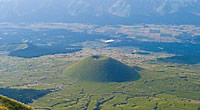
Typical lava dome (Komezuka, Aso city, Kumamoto prefecture)
Andesite is a kind of igneous rock made of solidified lava spewed out of a volcano. Igneous rock is divided into rhyolite, andesite, and granite, depending on the ratio of minerals or constituents contained in the magma, the base of lava, as shown in the "Types of Igneous Rock" in the panel of the Types of Rock, as above.
The sample andesite is solidified magma ejected out of Mt. Yakedake.
How a volcano erupts is also affected by the constituents of magma.
[Stickiness of Lava and Patterns of Eruption]
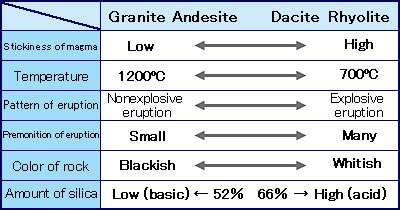
While stickiness of magma is affected by the amount of material, or silica, contained in the magma, many volcanoes with granitic silica-poor magma erupt in a mild way because of less sticky magma. On the other hand, volcanoes with rhyolitic silica-rich magma tend to cause explosive eruption. Andesitic magma may cause explosive eruption but also form lava domes. It is understood that many volcanoes in Japan are andesitic ones.
Reference: Earth Watching in Gifu, Gifu Prefecture High School Earth Science Education Research Association; Geology of Kamikochi, Satoru Harayama, Geological Survey of Japan; and photo: Aso Geopark Promotion Council
(4) Sandstone
- Type:
- Sedimentary rock (Tedori Group)
- Sampling site:
- Anagetani, Kansaka, Okuhida Hot Spa
As shown in the above panel, the History of the Land of Gifu Prefecture, sand banks were formed in what was originally the sea by sediments brought downstream by rivers flowing in the continent, the sea waters were closed because of this sedimentation, and a large lake (or a group of lakes and ponds) was consequently formed covering a wide area over the present Ishikawa, Fukui and Gifu prefectures. On the bottom of this big Lake Tedori were deposited sediments brought by rivers containing carcasses of organisms and plants that lived in an area where the place was once the sea.
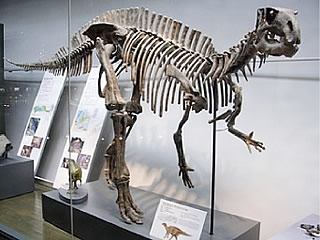
This stratum is called Tedori Group, which is nationally known for its discovery of various fossils. A survey that started in 1989 found dinosaur fossils. The fossils were restored in 1995 and named Fukuisaurus as a new species of dinosaur in 2003. Sample rocks contain conglomerates of various sizes. We feel very impressed when we learn that these rocks were formed from sedimentary rocks deposited on the bottom of a lake about 100 million years ago. Today's Lake Tedori located upstream of the Tedori River, Ishikawa prefecture, is an artificial reservoir created by construction of the Tedori Dam in 1979.
Reference: Earth Watching in Gifu, Gifu Prefecture High School Earth Science Education Research Association; Geology of Kamikochi, Satoru Harayama, Geological Survey of Japan; and photo: Fukui Prefectural Dinosaur Museum
(5) Sandstone
- Type:
- Sedimentary rock (Mesozoic Formation of the Mino Belt)
- Sampling site:
- near the Hirayu Otaki Falls, Hirayu, Okuhida Hot Spa, Takayama city
The Mesozoic Formation of the Mino Belt is a rock unit widely distributed from the upstream area of the Hirayu River to the mountain top and the eastern side of the North Japan Alps. It was formed in the period from the early stage to the medium stage of the Mesozoic (about 250 million to 66 million years ago) as the layers deposited in the sea bottom were gradually added to the continental plate by plate drift. Therefore, a large number of fossils of marine life have been found in this formation.
The Mino Belt was covered by volcanic rocks (Nohi rhyolite) because of volcanic activities of various mountains of the North Japan Alps including Mt. Hodake that started about 100 million years ago, as shown in the above panel, the History of the Land of Gifu Prefecture. Thereafter, the earth of this belt resurfaced with the progress of the rise of the North Japan Alps to what it is today as a result of subsequent plate activity.
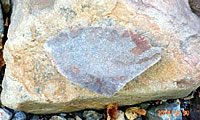 Sandstone that contained large conglomerate
Sandstone that contained large conglomerate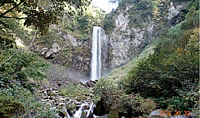 The Mino Belt (sedimentary rocks) is seen on your left hand side, while the Hirayu Otaki Falls covered by the lava of Norikura volcano on your right.
The Mino Belt (sedimentary rocks) is seen on your left hand side, while the Hirayu Otaki Falls covered by the lava of Norikura volcano on your right.
Reference: Earth Watching in Gifu, Gifu Prefecture High School Earth Science Education Research Association; Geology of Kamikochi, Satoru Harayama, Geological Survey of Japan; photos: Jinzu River Sabo Office, Hokuriku Regional Development Bureau, MLIT
(6) Rocks downstream of the Jinzu River
- Types:
- Igneous rock, sedimentary rock, and metamorphic rock
- Sampling site:
- near the park on the left bank of the Jinzu River, Arisawa, Toyama city
The Gamada River and Hirayu River, which drain the Okuhida area, join to become the Takahara River and again join the Miya River near Inotani, Toyama city, to become the Jinzu River.
Rocks on display as samples were brought downstream from the Okuhida area over time because of the force of the flowing water of a river occurring as a result of flood by heavy rainfall. As rocks were being conveyed downriver, originally angular rocks were broken or shaved to gradually become round. Rocks of various different features, including granite and andesite deeply related to volcanoes and sandstone formed by sand and mud deposited on the sea or river bottom, are on display.
![]() What kind of rock do these samples on display here correspond to?
What kind of rock do these samples on display here correspond to?
Hint:Think about the characteristics of rocks and guess which is which.
(The answer is in the back of each sample.)
Text and photo: Jinzu River Sabo Office, Hokuriku Regional Development Bureau, MLIT
